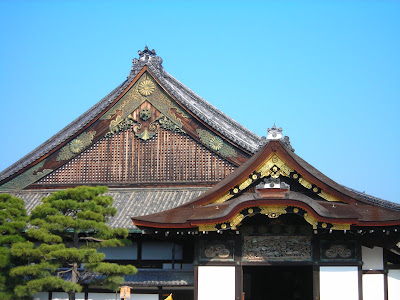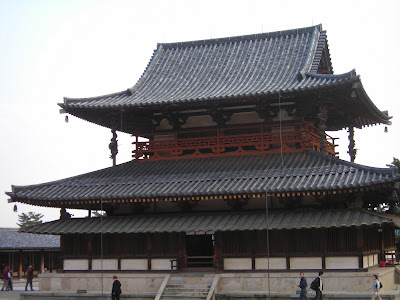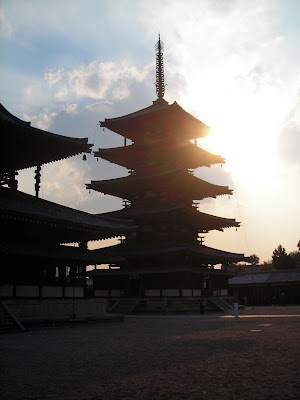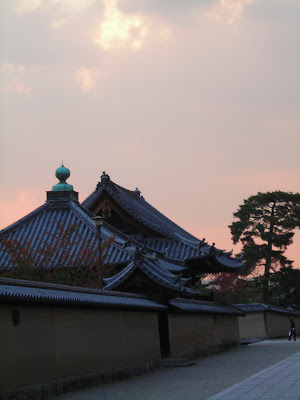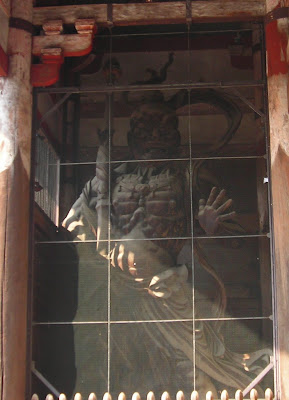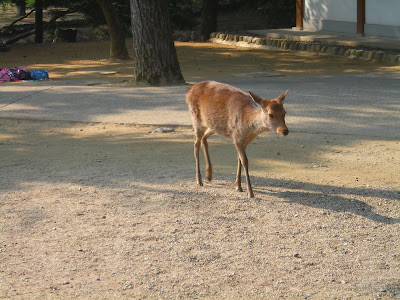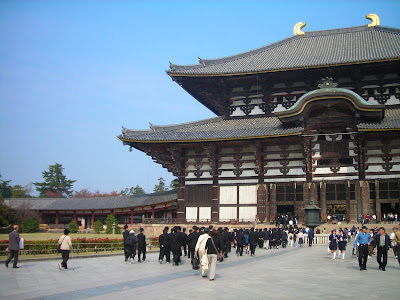Koyasan
My last day in Kyoto I packed up my bags and headed out for a whole new place--a mountain called Koyasan, a few hours away from Kyoto. It's the center of Shingon Buddhism (a particular sect) and it's absolutely packed with temples. It's also got a famous cemetary which holds many historic graves. Because it's so full of temples, it's a good place to stay at a temple overnight--which is what I wanted to do. I stayed at a place called Shojosho-in. It's one of the older temples and right next to the cemetary--it came highly recommended. It cost about $100 per night (although that included breakfast and dinner) so it was definitely a one night kinda thing for me! I even paid extra for a room with a garden view...
It was quite a trip to Koya-san. The trains were not exactly up to scratch, compared to Tokyo! The public transportation was quite limited and I had to plan it all out very carefully, to make all of my connections. But it all worked out. The train up to Koyasan was elderly and creaking; it ran through high mountains and rural villages. Included in the price for the ticket to Koyasan was a transfer to the cable line that runs you up to the mountain proper--it was very steep!
Koyasan, despite what it sounds like, is not exactly an isolated mountain paradise. It's a popular tourist destination. But it was still very pretty. When I finally found my temple, there was no one around and so I left my suitcases (I'd been in Japan for quite a long time by then--I'd never have done that in America!) and wandered around the place looking for someone. The only people I saw seemed to be cleaning up the place--junior monks? But eventually it all got sorted out. My Japanese almost fooled the lady into believing I actually knew how to speak it properly! I was proud of myself. My room was amazingly spacious and up some large, dark wood staircases. It was very traditional--futons, tatami mats, alcoves, even a kotatsu--the whole bit. It was very classy. It gets cold at night up there in the mountains, so we got a yukata and an overcoat. Below is the view from the temple... I couldn't take many pictures, unfortunately, cause my camera died and the replacement batteries I bought were defective.
Dinner was in an hour or so, so I decided to wander about the town a bit. I had temple fatigue so I had no real plans--just walked about. I found this little Shinto shrine up a hill...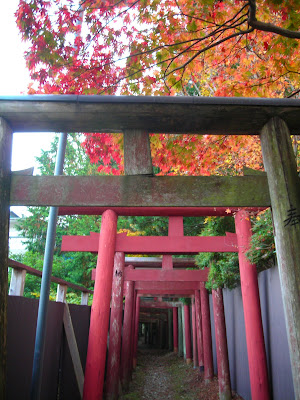
It was very atmospheric. There were a lot of temples--but I didn't really have time to visit any. I wanted to get back before dinner (and before it got dark.) I was in an unfamiliar town, even if it was Japanese. Dinner itself was very cool and very weird. All the guests ate in different, with about 4 people to a room. My room had 4 people--me, a fellow gaijin a few years older than me, and a middle-aged Japanese couple (a man and a women, but apparently they were just friends.) The other gaijin was much better at Japanese than me, but I still managed to follow the conversation somewhat, and it was really fun. The food itself was amazing--some of it may not have been delicious, per se--too strange--but it was still absolutely fascinating to try. One of the things that sticks out most was the tempura. It was all vegetarian, of course, being a Buddhist temple, so no gross seafood. It was all vegetables--daikon, lotus root, some kind of leaf. It was all cold, and yet it was ridiculously tasty.
We lingered quite a long time at dinner, chatting and enjoying the atmosphere. After dinner I decided to try to take a bath. It was communal and very old school--luckily I was the only one there. I washed myself off under the shower taps and then ventured into the big communal bath--it was made of wood! It was super-hot and felt REALLY great--especially since it was getting really cold by then. Luckily there were lots of blankets in my room and I stayed toasty warm in my comfortable futon. I went to bed early--the service the next morning was at 5:30 or 6 AM.
The service itself was pretty cool. The monks read from the sutras, etc. They had a nun, too. Afterwards, we had a traditional Japanese breakfast, but luckily no raw eggs in rice were to be seen (vegetarians!) After breakfast, I packed up and went directly to the cemetery right next door. The sun was just rising and coming in through the trees--the cemetery was in a large forest, stretched out along the side of the road, and on the other side (opposite from my temple) was another temple. So I decided to walk through it. It was really stunning--the light was amazing, the memorial stones were fantastic--all kinds of statues, some really old and some almost brand new. It was pretty quite most of the time, since it was so early. I walked all the way to the temple, which is the starting point for a pilgrimage, so I saw a lot of pilgrims--that was cool. Then I walked back to my temple and took off--I had to make it back in time for the shinkansen to Yokohama and then to my concert that night. It was pretty crazy--I was traveling all day and I went from rural Kansai to downtown Yokohama in one day. Quite a switch.
The end!
